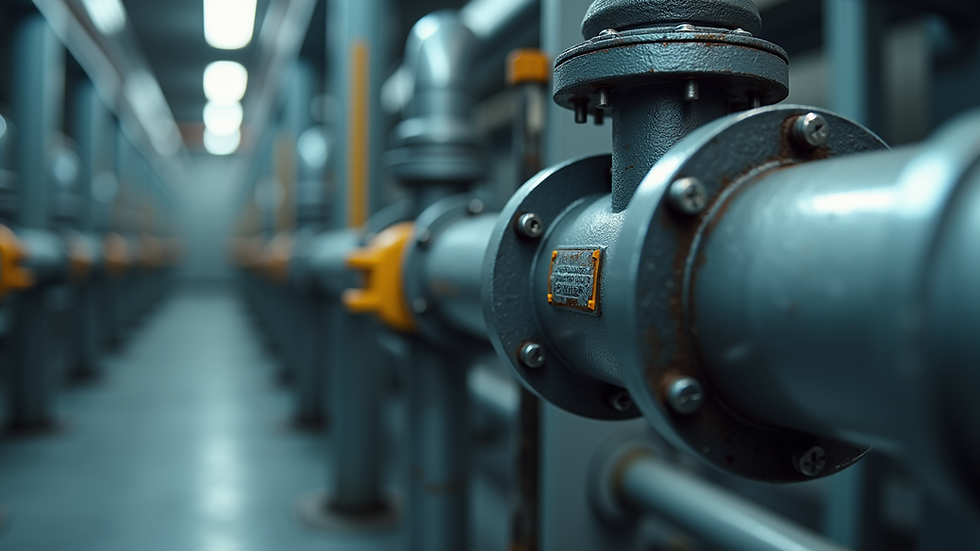Why Pressure Relief Valves Are Vital for System Safety
- UNIQUE CONTROL SYSTEMS

- 5 days ago
- 3 min read
In many industrial and mechanical systems, maintaining safe pressure levels is crucial to prevent accidents and equipment damage. System safety valves play a key role in this process by protecting pipelines, vessels, and machinery from excessive pressure buildup. Without these valves, the risk of catastrophic failures increases significantly, leading to costly repairs, downtime, and even threats to human safety.
Understanding the importance of these valves helps operators and engineers design safer systems and implement effective maintenance strategies. This article explores why system safety valves are indispensable, how they function, and what makes them a critical component in pressure management.
The Role of System Safety Valves in Industrial Systems
System safety valves are designed to automatically release pressure when it exceeds a predetermined limit. This prevents pressure from reaching dangerous levels that could cause explosions, leaks, or structural damage. They act as a fail-safe mechanism, ensuring that the system operates within safe parameters.
For example, in steam boilers, pressure can build up rapidly due to heat. A safety valve will open to release steam and reduce pressure, preventing the boiler from rupturing. Similarly, in chemical processing plants, these valves protect reactors and pipelines from overpressure caused by chemical reactions or blockages.
Key benefits of system safety valves include:
Protecting equipment from damage due to overpressure.
Ensuring personnel safety by preventing accidents.
Maintaining system integrity and avoiding costly downtime.
Complying with safety regulations and industry standards.

How System Safety Valves Enhance System Safety
System safety valves contribute to overall safety by providing a reliable pressure relief point. They are typically set to open at a specific pressure threshold, which is carefully calculated based on the system’s design limits. When pressure reaches this set point, the valve opens quickly to vent excess fluid or gas.
This rapid response is essential because pressure can rise unexpectedly due to equipment failure, blockages, or operational errors. By releasing pressure promptly, the valve prevents the system from reaching a critical failure point.
Moreover, these valves are designed to reseal after relieving pressure, allowing the system to return to normal operation without manual intervention. This automatic reset feature minimizes downtime and maintains continuous protection.
Operators should regularly inspect and test system safety valves to ensure they function correctly. Over time, valves can become corroded, clogged, or misaligned, which may impair their ability to open at the correct pressure.

What is PSV and PRV?
PSV (Pressure Safety Valve) and PRV (Pressure Relief Valve) are two common types of system safety valves, each with specific functions and applications.
Pressure Safety Valve (PSV): This valve is designed to open rapidly at a set pressure to protect equipment from overpressure. It is typically used in systems where pressure can rise quickly and dangerously, such as boilers and pressure vessels. PSVs are often spring-loaded and provide a full lift to release pressure immediately.
Pressure Relief Valve (PRV): PRVs open gradually as pressure increases, allowing controlled release of fluid or gas. They are used in systems where pressure buildup is slower or where a gradual pressure reduction is preferred. PRVs help maintain system stability by preventing sudden pressure drops.
Both valves are essential for maintaining safe operating conditions. Choosing the right valve depends on the system’s pressure characteristics, fluid type, and safety requirements.

Practical Tips for Maintaining System Safety Valves
Proper maintenance of system safety valves is critical to ensure they perform reliably when needed. Here are some actionable recommendations:
Regular Testing: Conduct periodic tests to verify that valves open at the correct pressure. This can involve manual lifting or using specialized testing equipment.
Visual Inspections: Check for signs of corrosion, wear, or damage. Look for leaks around the valve seat and body.
Cleaning: Remove any debris or buildup that could obstruct valve operation.
Calibration: Adjust the set pressure if system conditions change or if the valve drifts from its original settings.
Documentation: Keep detailed records of inspections, tests, and maintenance activities for compliance and troubleshooting.
By following these steps, operators can extend the lifespan of their valves and maintain system safety.
The Future of System Safety Valves
Advancements in technology are improving the design and functionality of system safety valves. Innovations include:
Smart valves with sensors that provide real-time monitoring of pressure and valve status.
Remote operation capabilities allowing valves to be tested or adjusted without physical access.
Improved materials that resist corrosion and wear, enhancing durability.
Enhanced sealing technologies to prevent leaks and improve reliability.
These developments help industries achieve higher safety standards and reduce operational risks.
For those interested in high-quality and reliable options, exploring pressure relief valves from trusted manufacturers can provide peace of mind and compliance with safety regulations.
Understanding and implementing system safety valves is essential for protecting equipment, personnel, and operations. By investing in proper valve selection, maintenance, and monitoring, industries can ensure safer and more efficient systems.





Comments